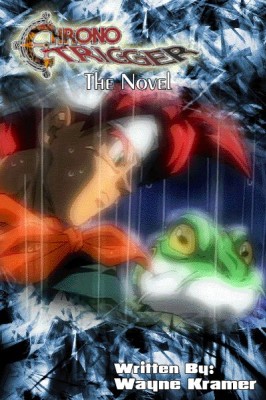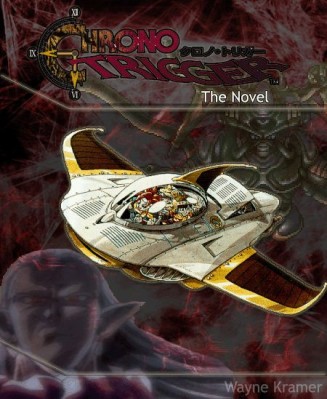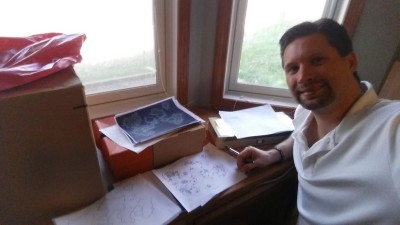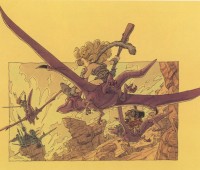Novel History

It all started back in September 1996, when I was just a mere 8th grader….
I had never before played Chrono Trigger, but one of my best friends, Luke, talked about it almost every day in science class. Finally, he let me borrow it, and, naturally, I started playing it…and I was instantly taken away by the rich and thrilling storyline. I found myself falling in love with the characters, always hoping that everything would work out for them. I felt for Frog as he brooded over a painful past, and I longed to help Marle as she coped with an overbearing father and the bondages of royalty. Themes of purpose, friendship, hope, spirituality, and determination abounded. By the end of it, the story so moved me that I called up Luke and said these exact words: “Someone should make a novel out of this!” Soon after, I would be the one to tackle that undertaking, but little did I know back then just how strong the calling would be. Chrono Trigger and this novel project give us a profound glance at mortality. It’s like that Green Day song, “Wake Me Up When September Ends,” where in the lyrics Billie Joe Armstrong sings “Twenty years has gone so fast.”
I’ve included this chronicled history of the novel for your enjoyment. By no means does it cover everything that has happened over the long history of this project. However, by reading this, you will see how the development of the Chrono Trigger Novel has been a truly organic experience which, like me, has grown stronger and more resilient with the passing of time.
The First “Novel”
My first run through this, as an eager-minded middle school student, was rough. In fact, it really wasn’t much of a novel at all. I captured basic character interactions, all the game’s dialogue, and I also captured all of the gaming elements. When Crono jumped to Level 4, I was all too happy to write that down. When Lucca found her Plasma Gun, it was jotted into the paragraph with utmost enthusiasm. Crono remained about as vocal as Brendan Frasier in Encino Man, or, that is, a caveman who doesn’t talk much. Occasionally, I drew charts on the pages which resembled the stat screens from the game, even including their tally of Experience Points. This continued for about 300 handwritten pages, until I finally went back and read them. Then I realized there had to be something more.
So, over a year later, in December of 1997, I started to modify my writing style. Believing that I could simply return to the first 300 pages and fix them at a later time, I continued with the story in the Beasts’ Lair leading to the Mountain of Woe. With three characters actively fighting, and the rest twiddling their thumbs at the End of Time, I figured that leaving out some of the items in the game would help the story to flow more smoothly. Indeed, this was a good move. It was also around this point that I decided to start adding scenes and chapters to further enrich the story—an even better move.
From this point on, I began watching what I was writing more closely and made many tweaks and improvements along the way. By around 340 pages, I decided not to include most weapons, armor, accessories, and the like, except those integral to the story. And, by this point, I was simply noting (in the side margin) when new Techs were being learned rather than interrupting the flow of the action for them. I began to take more liberties, always staying true to the canonical story but taking every opportunity to introduce more depth and background. Reading what I had done, I found myself much more satisfied than before, because the reading was much more enjoyable. It lacked much of the polished splendor of other high-quality fiction, owing largely to my youth and inexperience, but it was definitely coming along.
By around page 370, my writing had become considerably more developed. With my improved methodology, the novel was certainly at its best when compared to previous chapters. Looking back even now, I find myself engrossed with the sequences I wrote following the destruction of the Ocean Palace and the demise of a beloved character. I am amazed at a conversation between Gaspar and Spekkio that added depth to the mystery of the Time Egg.
In June 1998, I reached page 400 with the Golem Boss battle, and the story continued into the “optional” events of the game with the highest of hopes. I had a massive flow of ideas and an outline that would carry me the bulk of the way to the end of the game and its story. The novel, along with my writing style, had evolved. One always affected the other. Suddenly, however, came a turn for the worst, and my single three year-old game file (I had only one following the novel) was accidentally deleted on September 7th, 1999, almost exactly on the third anniversary since having started.
Looking back, that event was more devastating than it should have been. Obviously, I could simply have played the game back up to that point. So, it was probably the result of personal circumstances at the time that caused me to halt progress completely. I made notes regarding my plans for the events ahead of the novel and, with no other options, I began rewriting the novel from the beginning. This began the first draft of an entirely new first chapter, preceding the game’s opening. Unfortunately, the burden for me at the time became too great, and I stopped writing in October of that year. For an entire year those original 481 handwritten pages sat tucked away in large, brown envelopes.
Thankfully, my desire to finish it finally overtook my heavy heart, and I picked the novel back up where I had left it: in the middle of the new first chapter, continued in September 2000. (What it is about September and this project I have no idea.) From here, the foundation for the real novel was finally being laid….
The Next Stage
Thus began the next stage, the rewriting of the entire story that had already spent three years’ worth of pencil graphite and paper. I decided to continue writing everything by hand, using my trusty BiC 0.7mm mechanical pencil with green clip (which I still have to this day). At this time in late 2000, I had just entered my senior year of high school, and my writing had developed in strides. Scenes were adorned with descriptions to ensnare the senses, dialogue was freely added to enhance character interactions (finally, Crono had a personality and a voice), and story flow was improved to give the reader a more “real” experience. One could even say that the writing of the novel truly started here.
In this stage of the novel’s progress, the personality and spirit of the story I wanted to tell truly began to take form. Recall from earlier that this stage began with an entirely new first chapter, taking place the night before the kickoff of the Millennial Fair. Here Norstein Bekkler commenced his esoteric rhyme, and Crono nearly had a nervous breakdown after arriving into Truce 400 years in the past. In these pages, we hear the conversation between Lucca and her father, Taban, feeling his angst as his daughter fashions the Gate Key and heads into the mysterious portal Crono and Marle had just disappeared through. It’s in this account of the raid through Manolia Cathedral that two rescued soldiers, named Ian and Jonas, join in the fight to save the Queen; and, in an emotional tirade, Frog launches his buckler into the statue of Magus. Crono comforts Marle after she reappears from a time freeze, saying just what she needs to hear, and Lucca makes a stop in the local market to learn that their friend, Fritz is still missing. In this handwritten intro to the chapter covering Crono’s trial, a briefing takes place with his appointed attorney, Pierre. And, these highlights are from only the original first six chapters.
These sorts of story enhancements were not the extent of this stage’s logistics. At this point, I was keeping a keen eye on the passing of each day in the novel—indeed, even on the very time of day. I also kept a tally of more menial details, such as Marle’s count of arrows, Lucca’s count of darts, and the characters’ cash reserves, all charted out on the dark purple folder which held my handwritten pages. Occasionally, I took liberties which I later retreaded, such as changing the apocalyptic year to A.D. 2099. Even so, this underscores how every single storytelling opportunity was now being considered and weighed, a trend that would only intensify through the many edits that followed. To help organize the structure of each chapter, I created a comprehensive outline (also handwritten) for each chapter before writing. Instead of using only one game file, I used all three that the game would accommodate—one for outlining, one to follow the novel, and one for playing ahead so I could jot down summary notes about anything upcoming to keep in mind. Doing this also made it easier to capture those variations in dialogue which occur with different character combinations.
In this manner, I continued for 456 handwritten pages, until reaching the end of the battle with Magus. This now takes us into the range of February to March 2003, where the next stage of the novel’s development would begin. I suppose this amount of progress could have been worse, considering this span of the novel’s life followed me through graduating high school, taking on full-time work in our family business, and the first years of college.
It was at this point that I made the not-yet-final decision that the Chrono Trigger story may need to span more than one novel, and that this would be the most logical breaking point. After completing the action-packed chapters covering Magus’s Castle, I literally took a blank sheet of paper, drew the words “BOOK 2” in block letters, and wrote the title chapter beneath it: “Forward to the Past.” The rest of the page remains blank to this day, as finally the digitizing phase of the novel began….
Stage 3: Forward to the Computer
Okay, so actually I started typing up early chapters of the novel in 2001 and 2002, and the purpose of this was for releasing what I called the “Demo Chapter Package” onto the CTNP website. This package included chapters 2-5 and omitted the new first chapter so as to retain it as a bonus for the novel’s eventual publication. It was in March 2003, however, that I enlisted the “CTNP Editorial Team,” and we thus began a bold new initiative to edit all existing chapters. Given the personal nature of the project (as in, not being an actual company), this aspect of CTNP ran a pretty tight operation. E-Team members were required to submit applications and sign acceptance contracts. Later interviewing would consist of asking prospective members to submit edits of the publically available demo chapters, after which I would personally consider the level of contribution they were able to provide. Indeed, there were high hopes for this team.

Header image from the old CTNP website.
This stage of the project also proved to be lengthy beyond belief. Schedules became difficult to coordinate for team meetings. We all got caught up in life—most of us were around the same age, dealing with various stages of school, college, jobs, and early adult life. We would get through several chapters, only to find ourselves going back to the early chapters to review revisions, revise the revisions, and then review the revised revisions before considering how to further revise those revised revisions. While much was accomplished, this operation proved difficult for us to handle. Members dropped out for various reasons, sometimes to return later. I personally was very engrossed in both college and developing my career in the medical imaging equipment and parts field (I did, after all, have my livelihood to consider), and I found that a great deal of CTNP work was going into keeping up with the forum and our attempts at gaining public support through various low or no-budget outreach efforts.
Those efforts were all in good order, but the unfortunate effect was neglect of the one thing that mattered most: focus on completing the novel itself. It seemed editorial efforts were very light for a long period, while we conjured up various means of publicizing the project and pursuing support initiatives. It’s such a blur to think about it, but for a span of nearly three years, no new chapters were actually written.
That did change in 2006. Finally, I had graduated college (December 2005), but nearly all the time saved by no longer attending classes was pretty much occupied by work. A long time coming, the outline for the next new chapter was completed, and for over the next year several more chapters would be written whilst still editing through prior chapters.
Throughout the years of 2007 and 2008, CTNP became very engrossed in support efforts. Outside of CTNP, my professional responsibilities were only growing, as I began to take on an international scope of expansion in our family business. Editorial Team efforts did pick up during this time, and we once again had a solid group of individuals pouring through the chapters, even engaging in online conference meetings to discuss various opinions and ideas. Still, any serious editing really occurred in spurts. Eventually, as I reviewed where the novel was at, it was exhausting to see just how circuitous editing and support efforts within the project had become.

So, it was finally decided that all these support efforts had to come to a head. Without a lot of thought put into the actual still-unfinished status of the novel and the actual timing, a comprehensive and frankly impressive presentation packet was assembled and sent to Square-Enix’s headquarters in Japan. This took place in January 2009, and within about one month I had received their response. They did in fact claim to be impressed by what they saw but ultimately my proposal was rejected due to the copyright issues and an inability to allocate the resources necessary to put a plan into action. There wasn’t much more to it than that.
Even so, I took it at the time as a devastating blow. I took months to contemplate this and, late in the summer, I finally updated the website and decided that I still at least wanted to finish the novel itself. Maybe we’d have another shot in the future. Having this response did finally clear my plate of support outreach efforts, possibly the one aspect of CTNP that I could argue should never have been attempted. All it truly represented in the end was a massive distraction which produced no results...but it was an interesting ride.
Some editing and writing did continue in 2009 and even a little in 2010, but ultimately I found my heart just wasn’t quite in it. Even website updates dwindled to about once per year. So, needing some amount of closure, I took the opportunity to create a comprehensive outline all the way through to the ending of Chrono Trigger. This allowed me to adequately document my plans and ideas for the rest of the novel, for the ultimate “just in case”…just in case I might pick it up again.
And, in that state, the novel and everything in the CTNP sat dormant, all but left for dead. It seemed that would be my status indefinitely, until something changed much later, in the fall of 2015….
The Straight and Narrow
Over the years since the project’s nearly-official dormancy, I periodically found myself contemplating its plight. During these years, from 2010 on, very interesting things were happening in my career. In fact, things got a little wild. My job in the family business was stable, but I had taken on a new venture with a friend that brought us into the world of private clubs, direct-to-consumer retail, and eventually product design and sales for licensed brands (Garfield, Felix the Cat, Legends of Oz…). This period of time led to an interesting intermingling of professional worlds, which ultimately became so involved that I shifted from full-time in the medical “B2B” field to full-time in the consumer retail field and part-time medical world. To make another long story short, these new ventures ultimately ended, our family business was sold, and I found myself back in the medical field with my own company. (You can get a more detailed summary of my professional history via my personal LinkedIn page.)
It was, however, something about coming out of the licensed brands and entertainment industry that changed my thinking. A lot about me matured and evolved over these years, which affected my perceptions on a number of things—business, family (we had our first child in 2011), friendships, professional relationships, products, finances, faith, and life in general. And, for whatever reason, I found myself starting to go back just to read all of the novel that I had written—all of the planned first book and beyond into the second.
I must have read it at least two or three times, and as I did a new plan began forming in my mind. I suddenly began to understand that CTNP had never effectively approached this project from the perspective of a business, and certainly not with an understanding of the entertainment industry. It’s hard to explain how I didn’t recognize more of this before, but suddenly things were becoming remarkably clear. I realized that, from my recent whirlwind years chasing multifaceted career goals, I had a route to follow—a direction I could possibly take that might actually give the novel a chance. That was when I made a single phone call that changed everything.
I spoke to an individual named Travis, a business contact I had gained in the field of licensed products and someone I knew had a pulse on the landscape. What he told me resonated unlike anything before, because now I finally understood—now my mind was more properly aligned with this field at its level. And what I took from that call was simple in concept: complete that first novel and get it publisher-ready.
And thus was sparked the novel’s single greatest evolution in over six years of time and possibly even since its initial inception….
A Novel Aged like a Fine Wine
 Developing New Maps of Guardia Kingdom for the Chrono Trigger Novel.
Developing New Maps of Guardia Kingdom for the Chrono Trigger Novel.What has happened since is almost hard to explain. By this time in October 2015, I was running my own business which was both successful and operationally simple. Aside from occasional traveling, I had managed to keep operations to my home office. Not only had I achieved a solid financial position (fully recovering from the losses of the previous ventures), but I had total discretion and flexibility over my time.
This time things would be different. I wasn't winging it. I took on no CTNP Editorial Team or Committee. I did update the website, but generally updates became no more frequent. I spent no time in the forum or on considering support outreach. Rather, I started to spend more time reading and interfacing with new professional contacts of significance to the project. My mind afresh, I contemplated the novel’s chapters and how I truly wanted this novel to feel once finished. I knew I wanted an epic fantasy series, not just a really good game adaptation. This time, it was just me and the novel, and nothing would get in my way.
Passion overtook me, and the novel quickly took form in ways I would never before have imagined. Though I had not worked on the novel for years, I found my writing sharper than ever. Perhaps it was simply the experiences of life which had enhanced my skill. In the period from late 2015 and through the summer of 2016, more editorial progress was made on the novel than what had ever been accomplished in all the years prior. That’s almost embarrassing to admit for all the years past, but on the other hand it’s a remarkable achievement. It’s a testament to just how significant true focus can be. I devoted nearly full-time hours to the novel, spending late-night hours while my wife and daughters slept and balancing the entirety of my workdays between the novel and my business. Whenever I traveled, I spent any lengthy flights and spare time in hotels tweaking the novel, making it as good as I could.
Amazing developments ensued, all being so very recent. Detailed memos and notes were created to tackle the hardest subjects of the Chrono saga, things like the Entity, the planet, mechanics of time travel, and a finally defined size and scale of Guardia Kingdom. I updated the novel outline and reformed it for what would decidedly need to be a three-book series for Chrono Trigger. Because nobody else in the fan community had done it comprehensively, I began creating a full script for the Nintendo DS version of Chrono Trigger. I created and sketched new maps with a specific scale, rounding out the epic feel of this fantasy world. As all of this developed, many chapters of the novel took on heavy edits or even complete rewrites.
September 2016 marked the starting round of beta reading. The first round included known fans of the game who had been part of the past CTNP team, none of which had seen anything of my novel for at least six years. By the next month I was already starting a second round of beta reading, bringing in all females and people who had no prior exposure to the game. I got fantastic feedback and began keeping some metrics. More edits and rewrites followed, and I opened up a third round of beta reading in April 2017. The average score from all readers across all rounds is an 8 out of 10. So, I can't say the novel is perfect, but I am certainly pleased with the progress.
Through it all, I can tell you the final novel will be an experience to behold—something that even long-time fans will find to be an amazing new adventure.
Moreover, I had a true heart-to-heart with myself, finally admitting that I was never ready for this to happen before. Now, the novel is more than a publication initiative. It has become a true calling and purpose for my life, something that I've realized I could devote the rest of my professional life doing. It has become what the late Napolean Hill would call my “burning desire,” dominating my thoughts and dreams and ambitions both day and night. I am, in essence, overtaken by all the possibilities of Chrono, and I am excited for what the future holds.
In Closing
Though excessively wordy, I hope you have found this detailed account of the novel’s history interesting, and I thank you for allowing me to share this experience with you. Never give up hope when you truly believe in an ideal. It is my own dream that this project will one day stand as a testament to the power of perseverance and conviction.
Farewell for now, and may we one day have the opportunity to meet over a book-signing event and reminisce about the journey that time itself could never stop.




 Facebook
Facebook Mailing List
Mailing List